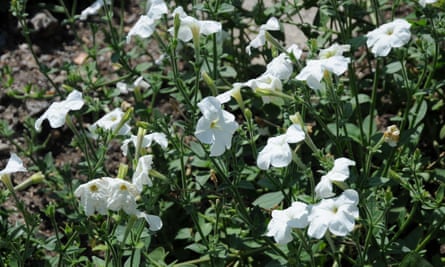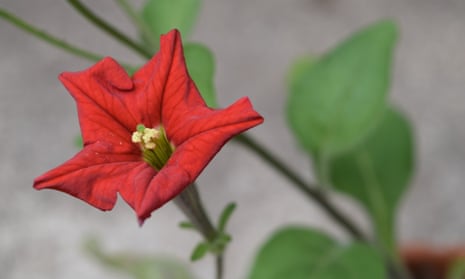I am not one for annuals or bedding plants. I struggle each year to find something I like for the hanging basket at the front door. In future, however, this isn’t going to be a problem. I have now found something that’s perfect for the job and I intend to stick with it.
The Guardian’s product and service reviews are independent and are in no way influenced by any advertiser or commercial initiative. We will earn a commission from the retailer if you buy something through an affiliate link. Learn more.
Earlier in the year I was given a plant that I fell in love with instantly; it was a petunia. It isn’t just any petunia, it’s Petunia exserta from Brazil and I didn’t just fall in love with its lovely cheery (but not overdone) red flowers, but I fell in love with its story too. It is a story that will tug at anyone’s heartstrings.
Only described in 1987, it really isn’t like any other petunia. That’s not because of its looks - it resembles some of the red forms of the standard bedding petunia - but because it’s the only petunia species that has evolved to be pollinated by hummingbirds; the others are pollinated mostly by moths. It isn’t scented like all the other species of petunia either, because hummingbirds aren’t much attracted to scent. It evolved, unlike all the other petunia species, to grow in shady, rocky refuges where its bright red colouring would be very necessary to attract its fast-flying pollinators.
I can’t help feeling very sorry for this plant. In the wild it is being pushed to the brink of extinction by another petunia. Petunia axillaris (one of the parents of all our bedding petunias) is hybridising with it and at the last count, in 2007, scientists only found 14 true Petunia exserta plants were left. Add to this the usual range of pressures such as habitat loss and climate change, and the lonely little Petunia exserta has become doomed to extinction.

It was introduced to British cultivation in 2014 by Derry Watkins of Special Plants Nursery. She managed to source some seeds from the USA where it had been brought into cultivation from Brazil by Joseph Tychonievich. Watkins, realising that this plant would hybridise easily with other petunias, vowed never to grow bedding petunias whilst growing little Petunia exserta, thus keeping the seeds she supplies pure.
If this poor, lonely, little plant is to survive as a species, it may be down to us gardeners to take a similar pledge. If we grow it then we have to either vow not to grow it alongside its bully hybrid cousins, or if we do we must remember not to grow the seed that it produces and supply it to others as Petunia exserta. Interestingly, it does not hybridise with Calibrachoa (Million Bells), a close petunia relative.
I am so pleased to have found this plant, and relieved that my annual search for annuals to grow in the hanging baskets is over. I don’t grow any other petunias that will hybridise with it, and my neighbours are all prepared to do the same. It will do exactly the same job of brightening up my front doorway as its bolder relatives would, and I will know that I am keeping this lonely little petunia safe in its own little patch.

Comments (…)
Sign in or create your Guardian account to join the discussion